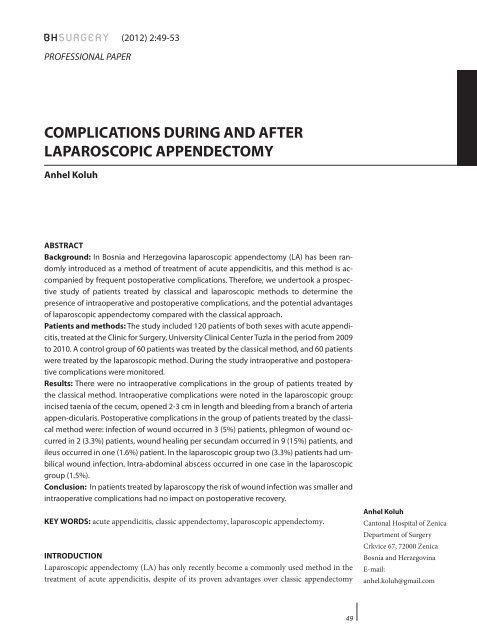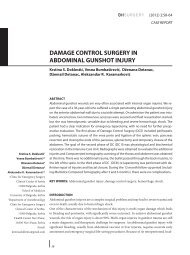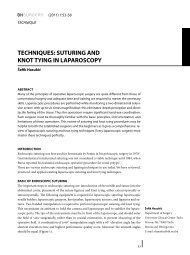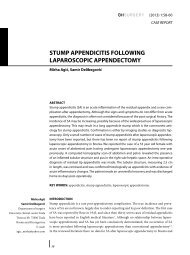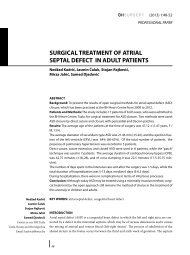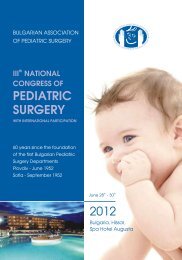complications during and after laparoscopic appendectomy
complications during and after laparoscopic appendectomy
complications during and after laparoscopic appendectomy
Create successful ePaper yourself
Turn your PDF publications into a flip-book with our unique Google optimized e-Paper software.
PROFESSIONAL PAPER<br />
(2012) 2:49-53<br />
COMPLICATIONS DURING AND AFTER<br />
LAPAROSCOPIC APPENDECTOMY<br />
Anhel Koluh<br />
ABSTRACT<br />
Background: In Bosnia <strong>and</strong> Herzegovina <strong>laparoscopic</strong> <strong>appendectomy</strong> (LA) has been r<strong>and</strong>omly<br />
introduced as a method of treatment of acute appendicitis, <strong>and</strong> this method is accompanied<br />
by frequent postoperative <strong>complications</strong>. Therefore, we undertook a prospective<br />
study of patients treated by classical <strong>and</strong> <strong>laparoscopic</strong> methods to determine the<br />
presence of intraoperative <strong>and</strong> postoperative <strong>complications</strong>, <strong>and</strong> the potential advantages<br />
of <strong>laparoscopic</strong> <strong>appendectomy</strong> compared with the classical approach.<br />
Patients <strong>and</strong> methods: The study included 120 patients of both sexes with acute appendicitis,<br />
treated at the Clinic for Surgery, University Clinical Center Tuzla in the period from 2009<br />
to 2010. A control group of 60 patients was treated by the classical method, <strong>and</strong> 60 patients<br />
were treated by the <strong>laparoscopic</strong> method. During the study intraoperative <strong>and</strong> postoperative<br />
<strong>complications</strong> were monitored.<br />
Results: There were no intraoperative <strong>complications</strong> in the group of patients treated by<br />
the classical method. Intraoperative <strong>complications</strong> were noted in the <strong>laparoscopic</strong> group:<br />
incised taenia of the cecum, opened 2-3 cm in length <strong>and</strong> bleeding from a branch of arteria<br />
appen-dicularis. Postoperative <strong>complications</strong> in the group of patients treated by the classical<br />
method were: infection of wound occurred in 3 (5%) patients, phlegmon of wound occurred<br />
in 2 (3.3%) patients, wound healing per secundam occurred in 9 (15%) patients, <strong>and</strong><br />
ileus occurred in one (1.6%) patient. In the <strong>laparoscopic</strong> group two (3.3%) patients had umbilical<br />
wound infection. Intra-abdominal abscess occurred in one case in the <strong>laparoscopic</strong><br />
group (1.5%).<br />
Conclusion: In patients treated by laparoscopy the risk of wound infection was smaller <strong>and</strong><br />
intraoperative <strong>complications</strong> had no impact on postoperative recovery.<br />
KEY WORDS: acute appendicitis, classic <strong>appendectomy</strong>, <strong>laparoscopic</strong> <strong>appendectomy</strong>.<br />
INTRODUCTION<br />
Laparoscopic <strong>appendectomy</strong> (LA) has only recently become a commonly used method in the<br />
treatment of acute appendicitis, despite of its proven advantages over classic <strong>appendectomy</strong><br />
Anhel Koluh<br />
Cantonal Hospital of Zenica<br />
Department of Surgery<br />
Crkvice 67, 72000 Zenica<br />
Bosnia <strong>and</strong> Herzegovina<br />
E-mail:<br />
anhel.koluh@gmail.com<br />
49
(CA) 1,2 . In Bosnia <strong>and</strong> Herzegovina <strong>laparoscopic</strong> <strong>appendectomy</strong><br />
has been r<strong>and</strong>omly introduced, only in several<br />
centers, as a method of treatment of acute appendicitis.<br />
One of the reasons is that CA with McBurney’s incision<br />
is a simple, fast <strong>and</strong> efficient procedure. LA requires<br />
certain knowledge of <strong>laparoscopic</strong> surgery <strong>and</strong> more<br />
expensive equipment. Potential advantages such as the<br />
reduced number of wound infections, shorter hospital<br />
stay, faster recovery <strong>and</strong> return to everyday activities,<br />
were accompanied by a longer operative time <strong>and</strong> higher<br />
costs <strong>and</strong> more frequent postoperative <strong>complications</strong> at<br />
the time when the method was being accepted 3,4,5 . In the<br />
last two decades since <strong>laparoscopic</strong> <strong>appendectomy</strong> was<br />
introduced many papers have been published showing<br />
that it is a safe <strong>and</strong> feasible procedure in the treatment<br />
of acute appendicitis 6,7,8 .<br />
However, there are also some diverse reports demonstrating<br />
that the incidence of intra-abdominal abscess<br />
is higher, the time of surgery is extended <strong>and</strong> costs of<br />
treatment are significantly increased, whereas some<br />
reports do not find any significant difference in intraabdominal<br />
abscess, wound infections <strong>and</strong> the quantity<br />
of analgesics applied 9 . For that reason we conducted a<br />
prospective study involving patients treated by the classical<br />
<strong>and</strong> <strong>laparoscopic</strong> methods in order to establish the<br />
occurrence of intraoperative <strong>and</strong> postoperative <strong>complications</strong>.<br />
PATIENTS AND METHODS<br />
The study included 120 patients of both sexes with acute<br />
appendicitis, treated at the Clinic for Surgery, University<br />
Clinical Center Tuzla in the period from 2009 to<br />
2010. A control group of 60 patients were treated by the<br />
classical method, while 60 patients were treated by the<br />
<strong>laparoscopic</strong> method. Of the total number of operated<br />
patients using the classical method, 37 we are (61.66%)<br />
females with an average age of 26.05 years, at an interval<br />
from 15 to 55 years old <strong>and</strong> 23 (38.33%) were men, with<br />
an average age of 38 years, from 15 to 70 years old. In<br />
the group of patients treated by the <strong>laparoscopic</strong> method,<br />
30 (50%) were females <strong>and</strong> 30 (50%) were males.<br />
Criteria for inclusion in the study were: patients with<br />
acute appendicitis older than 14 <strong>and</strong> LA was performed<br />
by a surgeon who had done at least five such procedures<br />
in the past. Patients with secondary appendicitis caused<br />
by another clinical entity <strong>and</strong> patients, who had a <strong>laparoscopic</strong><br />
<strong>appendectomy</strong> converted into a classical one,<br />
were excluded from the study. The study monitored<br />
intraoperative <strong>and</strong> postoperative <strong>complications</strong> <strong>during</strong><br />
hospitalization.<br />
TECHNIQUE<br />
Classical <strong>appendectomy</strong><br />
Classical <strong>appendectomy</strong> was performed through the<br />
right iliac fossa using an alternate incision according to<br />
Sprengler. Having established acute appendicitis, dissection<br />
<strong>and</strong> ligation of the mesoappendix <strong>and</strong> appendix<br />
were performed. The wound was ligated with the Safil<br />
suture (Braun, Tuttlingen, Germany).<br />
Laparoscopic <strong>appendectomy</strong><br />
A patient is positioned on the surgery table in a deep<br />
Tr<strong>and</strong>elenburg position. The patient is leaned towards<br />
a surgeon. The surgeon <strong>and</strong> assistant st<strong>and</strong> on the left<br />
side <strong>and</strong> a monitor is positioned on the right side of<br />
the patient. Shortly before the surgery we apply a urinary<br />
catheter to decompress the urinary bladder <strong>and</strong> to<br />
avoid its injury <strong>during</strong> the application of the suprapubic<br />
ports. Pneumoperitoneum is achieved by insertion of<br />
the Veress needle through the umbilicus. Three ports<br />
are inserted: 10 mm port in the supraumbilical area using<br />
the closed technique, <strong>and</strong> there<strong>after</strong> two additional<br />
5 mm ports controlled by a camera – one in the suprapubic<br />
area, more to the left, <strong>and</strong> the other one in the<br />
right lower quadrant, at the level of the first 5 mm port<br />
in order to get a triangulation.<br />
When a decision to perform <strong>appendectomy</strong> is made,<br />
the mesoappendix is mobilized <strong>and</strong> recessed by an ultrasonic<br />
dissector (Ultrasonic Coagulating Shears, Ethicon,<br />
Endosurgery, Cincinnati, OH). Three endoloop 1/0<br />
Vicryl (Ethicon, Endosurgery) ligatures are there<strong>after</strong><br />
applied around the base of the appendix or two nonabsorbable<br />
hem-o-lok plastic clips of XL size are applied<br />
(Hem-o-lok, Weck Closure Systems, Research Triangle<br />
Park, NC, USA). The appendix is cut between ligatures<br />
or plastic clips with the ultrasonic dissector inserted<br />
through the 5 mm port. Abdominal toilet of the right<br />
paracolic gutter <strong>and</strong> Douglas pouch is performed using<br />
suction/irrigation. Whenever exudate appeared drainage<br />
was inserted into the pouch of Douglas.<br />
50
Table 1. Intraoperative <strong>and</strong> postoperative <strong>complications</strong> in classical <strong>and</strong> <strong>laparoscopic</strong> <strong>appendectomy</strong><br />
Pathohistological evaluation<br />
Gangrenous<br />
Phlegmonus<br />
Perforated<br />
Diffuse peritonitis<br />
Local peritonitis<br />
Intraoperative complication<br />
Opened cecum 2-3 cm<br />
Bleeding from arteria<br />
appendicularis<br />
Incised taenia<br />
Postoperative complication<br />
Properly coalesced wound<br />
Wound per secundam<br />
Wound infection<br />
Phlegm of wound<br />
Ileus<br />
Intraabdominalni abscess<br />
* <strong>laparoscopic</strong>ally situated<br />
** 5 i 10 mm clips with surgical<br />
*** <strong>laparoscopic</strong>ally situated<br />
Laparoscopic <strong>appendectomy</strong><br />
(n=60)<br />
33 (55%)<br />
27 (45%)<br />
7 (11,6%)<br />
3 (5%)<br />
3 (5%)<br />
1 (1,6%) *<br />
1 (1,6%) **<br />
1 (1,6%) ***<br />
57 (95%)<br />
0<br />
2 (3,3%)<br />
0<br />
0<br />
1 (1,6%)<br />
Classical <strong>appendectomy</strong><br />
(n=60)<br />
28 (46,6%)<br />
31 (51,6%)<br />
18 (30%)<br />
4 (6,6%)<br />
6 (10%)<br />
0<br />
0<br />
0<br />
45 (75%)<br />
9 (15%)<br />
3 (5%)<br />
2 (3,3%)<br />
1 (1,6%)<br />
0<br />
RESULTS<br />
In the group of patients treated by classical <strong>appendectomy</strong><br />
the largest number of them had phlegmonous<br />
changes of the appendix – 31 (51.66%) patients, whereas<br />
gangrenous appendix occurred in 33 (55%). patients<br />
treated with <strong>laparoscopic</strong> method.<br />
Comorbidity <strong>and</strong> intraoperative <strong>complications</strong><br />
Intraoperative <strong>complications</strong> noted in the <strong>laparoscopic</strong><br />
group included a cecum opened for 2-3 cm <strong>and</strong> bleeding<br />
from a branch of the arteria appendicularis <strong>and</strong> an<br />
incised taenia. No intraoperative <strong>complications</strong> were<br />
noted in the group of patients treated by the classical<br />
method.<br />
Postoperative <strong>complications</strong><br />
Among the patients treated with the CA, 3 (5%), had<br />
a wound infection, 2 (3.3%) experienced phlegmon of<br />
the surgical wound, 9 (15%) had a wound healing per<br />
secundam, <strong>and</strong> ileus occurred in 1 patient (1.6%). Two<br />
LA patients (3.3%) had an infection of the umbilical<br />
wound. Intraabdominal abscess occurred in LA in one<br />
patient (1.6%) (Table 1.).<br />
DISCUSSION<br />
Laparoscopic <strong>appendectomy</strong> has proven advantages<br />
over the open method. The risk of infection is lower,<br />
postoperative pain is less severe, <strong>and</strong> the hospital stay<br />
is shorter.<br />
Intraoperative <strong>complications</strong> were noted in the group of<br />
51
patients treated by the <strong>laparoscopic</strong> method (intestinal<br />
lesions <strong>and</strong> bleeding from mesoappendix) which were<br />
h<strong>and</strong>led <strong>during</strong> surgery, did not lead to conversion into<br />
an open procedure <strong>and</strong> had no impact on postoperative<br />
recovery.<br />
Trocar injuries represent a significant complication of<br />
<strong>laparoscopic</strong> surgery resulting in the most serious injuries,<br />
such as vascular injuries. The most common intraoperative<br />
complication of <strong>laparoscopic</strong> <strong>appendectomy</strong><br />
was bleeding from the mesoappendix 4,14 . There are different<br />
under-lying causes of an unsuccessful procedure<br />
– the most frequently stated reasons include the position<br />
of the appendix, adhesions, obesity, bleeding <strong>and</strong><br />
abscess 10,15 . Most of the reasons for conversions occur<br />
due to the insufficient experience of the surgeons. Of<br />
course they are very rare in cases of experienced surgeons.<br />
The learning curve of <strong>laparoscopic</strong> <strong>appendectomy</strong> gives<br />
five <strong>appendectomy</strong>, when the number of intraoperative<br />
<strong>and</strong> postoperative <strong>complications</strong> is reduced, <strong>and</strong> this<br />
operation can be recommended as a model for learning<br />
in <strong>laparoscopic</strong> surgery.<br />
Laparoscopy is characterized by decreased traumatization<br />
of tissue <strong>and</strong> lesser irritation of intestines, less severe<br />
postoperative pain <strong>and</strong> shorter stays in hospitals as<br />
well as faster recovery <strong>and</strong> return to normal activities,<br />
which is of special importance for patients who are supposed<br />
to return to work 11,12 .<br />
Five-millimeter trocars do not require the closure of the<br />
parietal wall, resulting in less postoperative pain <strong>and</strong> a<br />
smaller scar. As stated by other studies, the lower rate<br />
of infections of surgical wounds may be explained by<br />
the extraction of the inflamed appendix in an endobag,<br />
while in the group of patients treated by the classical<br />
method the healing of wounds was delayed in 25%. Delayed<br />
healing of wounds in combination with longer<br />
hospitalization <strong>and</strong> treatment with antibiotics significantly<br />
increases the cost of treatment 13,16 .<br />
Intra-abdominal abscess occurred in LA in only one<br />
case of uncomplicated appendicitis.<br />
It was treated with ultrasound guided drainage, the<br />
method that should have preference in the treatment of<br />
such kinds of <strong>complications</strong>. In open <strong>appendectomy</strong> intra-abdominal<br />
abscess occurs in 2 to 3% of cases. Most<br />
studies have noted a slightly higher incidence of abscess<br />
in <strong>laparoscopic</strong> <strong>appendectomy</strong>. Inappropriate techniques,<br />
which certainly include, for example, squeezing<br />
of the appendix <strong>during</strong> <strong>appendectomy</strong>, instead<br />
of seizing the mesentery, <strong>and</strong> inadequate toilet of the<br />
peritoneal cavity, result in a slightly higher incidence 9,17 .<br />
However, there is an increasing number of reports stating<br />
that there is no difference in the creation of an abscess<br />
in classical <strong>and</strong> <strong>laparoscopic</strong> <strong>appendectomy</strong>. This<br />
will certainly be achieved by improved experience of<br />
surgeons <strong>and</strong> better toilet of the intraperitoneal space6.<br />
In cases of perforated appendicitis there is an increased<br />
incidence of the creation of abscess, regardless of the<br />
kind of technique used.<br />
A limitation of this study is the size of the sample, but<br />
its results are consistent with other published studies.<br />
This study confirms previously conducted studies <strong>and</strong><br />
demonstrates that in patients treated by the <strong>laparoscopic</strong><br />
method the risk of wound infection is smaller;<br />
intraoperative <strong>complications</strong>, which do not affect the<br />
postoperative period, decrease with the number of surgeries<br />
performed.<br />
Acknowledgment:<br />
I thank the Department of Surgery of the University<br />
Clinical Centre, Tuzla, <strong>and</strong> my mentor, Prof.<br />
Delibegović for his assistance in undertaking this<br />
study.<br />
Received: 12 November 2011/Accepted: 14 May 2012<br />
REFERENCES<br />
1. Cueto J, D’Alemagne B, Va´ zquez-Frias J.A, Gonza<br />
R, Mansur H, Gomez S, et al. Morbidity of <strong>laparoscopic</strong><br />
surgery for complicated appendicitis: an international<br />
study. Surg Endosc. 2006;20:717-720.<br />
52
2. Semm K. Endoscopic <strong>appendectomy</strong>. Endoscopy.<br />
1983;15:59-64.<br />
3. Delibegović S, Matović. E Hem-o-lok plastic clips in<br />
securing of the base of the appendix <strong>during</strong> <strong>laparoscopic</strong><br />
<strong>appendectomy</strong>. Surg Endosc. 2009;23:2851-<br />
2854.<br />
4. Hansen JB, Smithers BM, Schache D, Wal D, Miller<br />
BJ, Menzies JL. Laparoscopic versus open <strong>appendectomy</strong>:<br />
prospective r<strong>and</strong>omized trial. World J Surg.<br />
1996;20:17-21.<br />
5. Guller U, Nitin J, Eric P, Lawrence M, Steve E, Ricardo<br />
P. Laparoscopic <strong>appendectomy</strong> in the elderly.<br />
Surgery. 2004;12: 479.<br />
6. Koluh A, Delibegović S, Hasukić Š, Valjan V, Latić<br />
F. Laparoscopic apendectomy in the treatment of<br />
acute apendicitis. Medical Archives. 2010;64:78-83.<br />
7. Namir K, Rodney J, Shirin T, Anna G, Rahila E.<br />
Laparoscopic versus open appen-dectomy. Surgery.<br />
2005;135:439-450.<br />
8. Ortega AE, Hunter JG, Peters JH, Swanstrom LL,<br />
Schirmer B. A prospective r<strong>and</strong>omized comparison<br />
of <strong>laparoscopic</strong> <strong>appendectomy</strong> with open <strong>appendectomy</strong>.<br />
Laparoscopic Appendectomy Study Group.<br />
Am J Surg. 1995;169:208-213.<br />
9. Pedersen AG, Petersen OB, Wara P, Ronning H,<br />
Quist N, Laurberg S. R<strong>and</strong>omized clinical trial of<br />
<strong>laparoscopic</strong> versus open apendicectomy. B J Surg.<br />
2001;88:200-205.<br />
10. Mutter D, Vix M, Bui A, Evrard S, Tassetti V, Breton<br />
JF, et al. Laparoscopy not recommended for <strong>appendectomy</strong><br />
in men: Results of a prospective r<strong>and</strong>omized<br />
study routine. Surgery. 1996;70-74.<br />
11. Kouwenhoven EA, Repelaer van Driel OJ, Erp WF.<br />
Fear for the intraabdominal abscess <strong>after</strong> <strong>laparoscopic</strong><br />
<strong>appendectomy</strong>: not realistic. Surg Endosc.<br />
2005; 19: 923-926.<br />
12. McAnena OJ, Austin O, O’Connell PR, Hederman<br />
WP, Gorey TF, Fitzpatrick J. Laparoscopic versus<br />
open appendicectomy: a prospective evaluation. Br<br />
J Surg. 1992; 79:818-820.<br />
13. Shabtai M, Rosin D, Zmora O, Munz Y, Scarlat A,<br />
Shabtai E, et al. The impact of a resident’s seniority<br />
on operative time <strong>and</strong> length of hospital stay for <strong>laparoscopic</strong><br />
<strong>appendectomy</strong>. Outcomes used to measure<br />
the resident’s <strong>laparoscopic</strong> skills. Surg Endosc.<br />
2004;18:1328-1330.<br />
14. Pier A, Gotz F, Bacher C. Laparoscopic <strong>appendectomy</strong><br />
in 625 cases: from innovation to routine. Surg<br />
Laparosc Endosc. 1991;1:8-13.<br />
15. Schreiber JH. Early experience with <strong>laparoscopic</strong><br />
<strong>appendectomy</strong> in women. Surg Endosc. 1987;1:211-<br />
216.<br />
16. Ludvig KA, Cattey RP, Henry LG. Initial experience<br />
with <strong>laparoscopic</strong> <strong>appendectomy</strong>. Dis Colon Rectum.<br />
1993;36:463-467.<br />
17. Liang MK, Helen GL, Marks JL. Stump Appendicitis:<br />
a comprehensive review of literature. The American<br />
Surgeon. 2006;72:162-166.<br />
53


